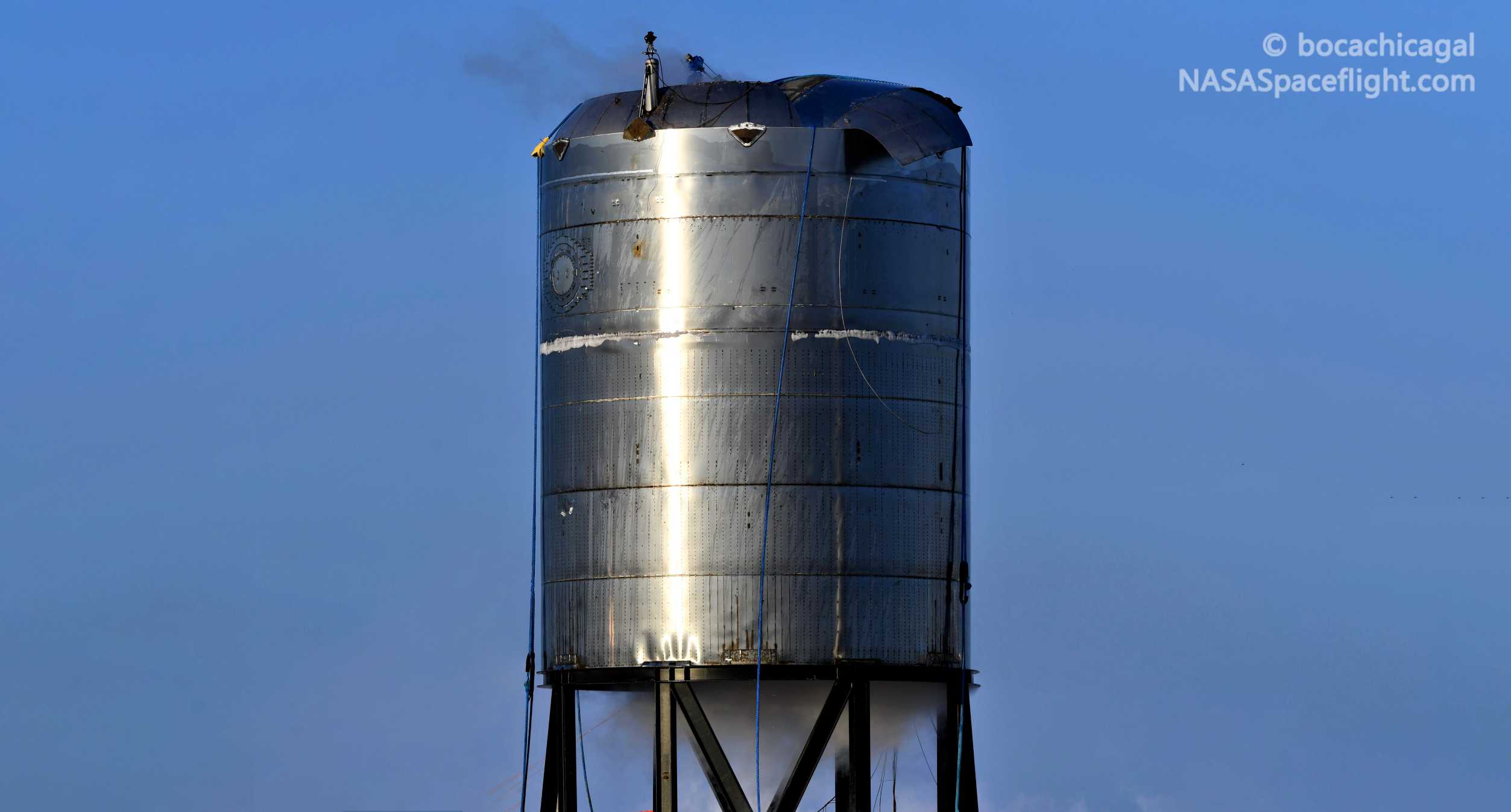
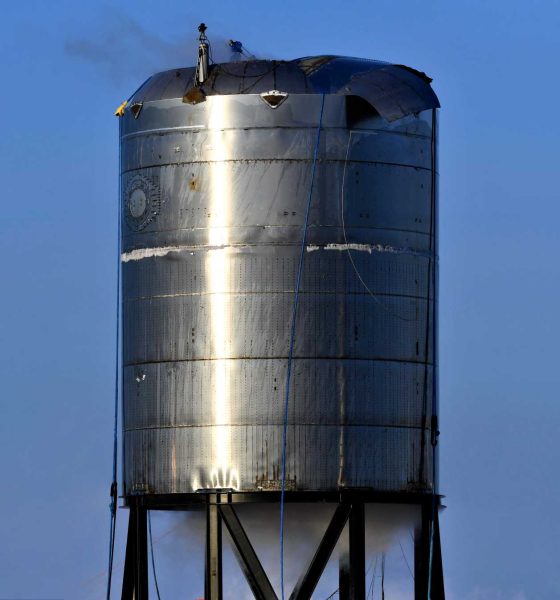
News
SpaceX Starship pop test opens the door for 60,000 foot hop [update]
SpaceX has successfully destroyed a Starship ‘test tank’ for the fourth time, opening the door for the first high-altitude prototype to roll to the launch pad as soon as tomorrow.
The culmination of three nights and more than 20 hours of concerted effort, SpaceX was finally able to fill Starship test tank SN7.1 with several hundred tons of liquid nitrogen before dawn on September 23rd. With just an hour left in the day’s test window, SpaceX closed the tank’s vents, allowing its cryogenic contents to boil into gas and expand with no outlet. At 4:57 am CDT, SN7.1 burst, bringing its lengthy test campaign to a decisive end.
A handful of hours later, new road closure notices revealed SpaceX’s plan to roll Starship SN8 – the first full-size prototype and first ship meant for high-altitude testing – from its Boca Chica factory to the launch site.
Update: All road closures planned for Starship SN8’s roll to the launch pad (Sept 24) and first test campaign (Sept 27-29) have been canceled. Stay tuned for updates on the high-altitude prototype’s test schedule.
Short of new information from SpaceX or CEO Elon Musk, little is known about the results of SN7.1’s lengthy test campaign, but the fact that it survived two nights of nondestructive testing – including the use of hydraulic rams to simulate Raptor thrust – effectively clears Starship SN8 for suborbital testing. Based on a speculative, amateur analysis of the aftermath of SN7.1’s burst test, it can also be tentatively concluded that the tank failed almost exactly where one would expect it to: the in-situ weld attaching the upper tank dome to SN7.1’s steel ring hull.
SN7.1’s forward dome appears to have cleanly sheared off around much of its circumferential weld joint – exactly what one would theoretically expect from a good, uniform weld. Assuming that SN7.1 reached pressures well above 8.5 bar (~125 psi) before it burst, the tank’s final test can likely be deemed a success.
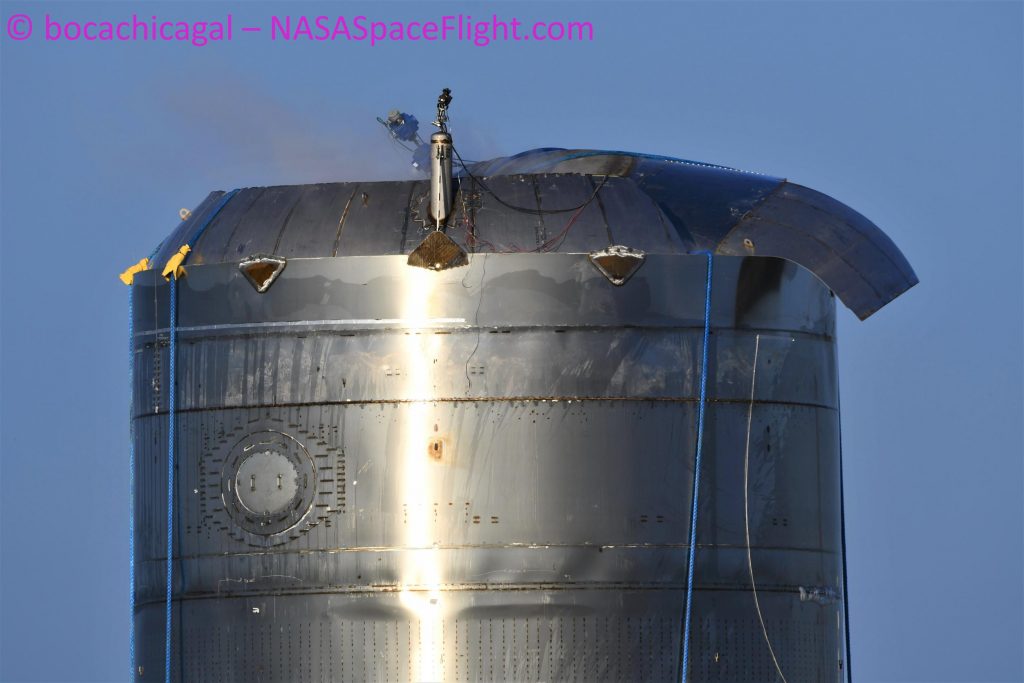
The very same day SpaceX kicked off what would become Starship SN7.1’s last burst test attempt, teams worked to install functional flaps on a full-scale Starship prototype (SN8) for the first time ever. Effectively answering the question of whether SpaceX would fully outfit the ship with a nosecone and flaps before its first acceptance tests, SN7.1’s successful pop was followed by road closure notices for SN8’s transport to the launch pad around dawn on September 24th and cryptic “SN8 Testing” as early as September 27th.
As of September 23rd, SN8’s twin aft flaps – large aerodynamic control surfaces meant to stabilize free-falling Starships – have been fully installed alongside ‘aerocovers’ that will protect each flap’s control mechanisms. The only hardware Starship SN8 is missing is a ~20m (~60 ft) tall nosecone, two smaller forward flaps, and the plumbing needed to access a smaller liquid oxygen “header” tank located in the tip of said nose.
At the moment, SpaceX has installed one Starship nosecone prototype atop five unpressurized rings – creating a full nosecone stack. That particular prototype has no liquid oxygen header tank, however, meaning that SpaceX would likely need at least a day or two to weld one of the noses with a header tank atop one of several finished five-ring sections. In other words, to transport SN8 to the pad tomorrow, there’s almost no chance that SpaceX will have time to finish and install a proper nosecone on the prototype, meaning that the company has chosen to test the Starship before that milestone.
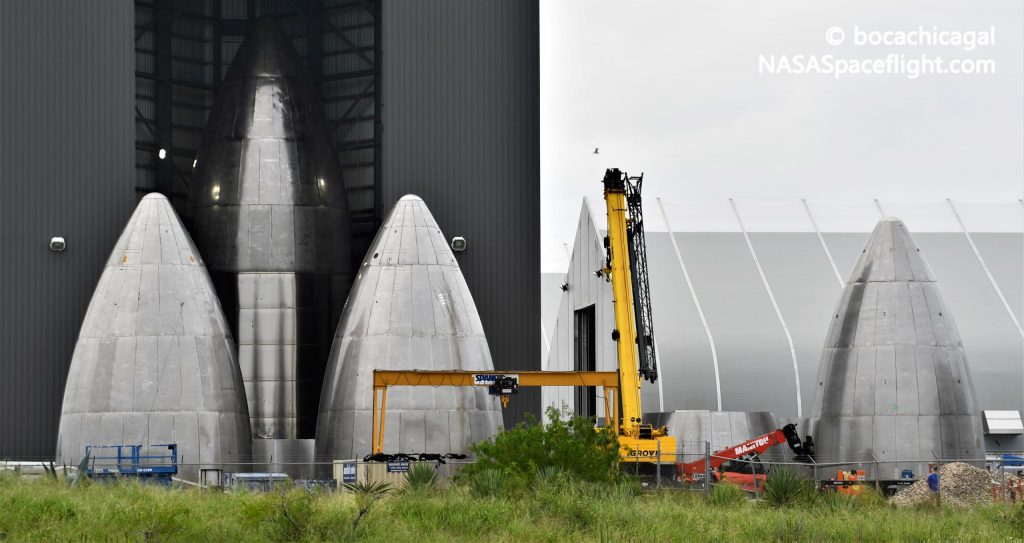
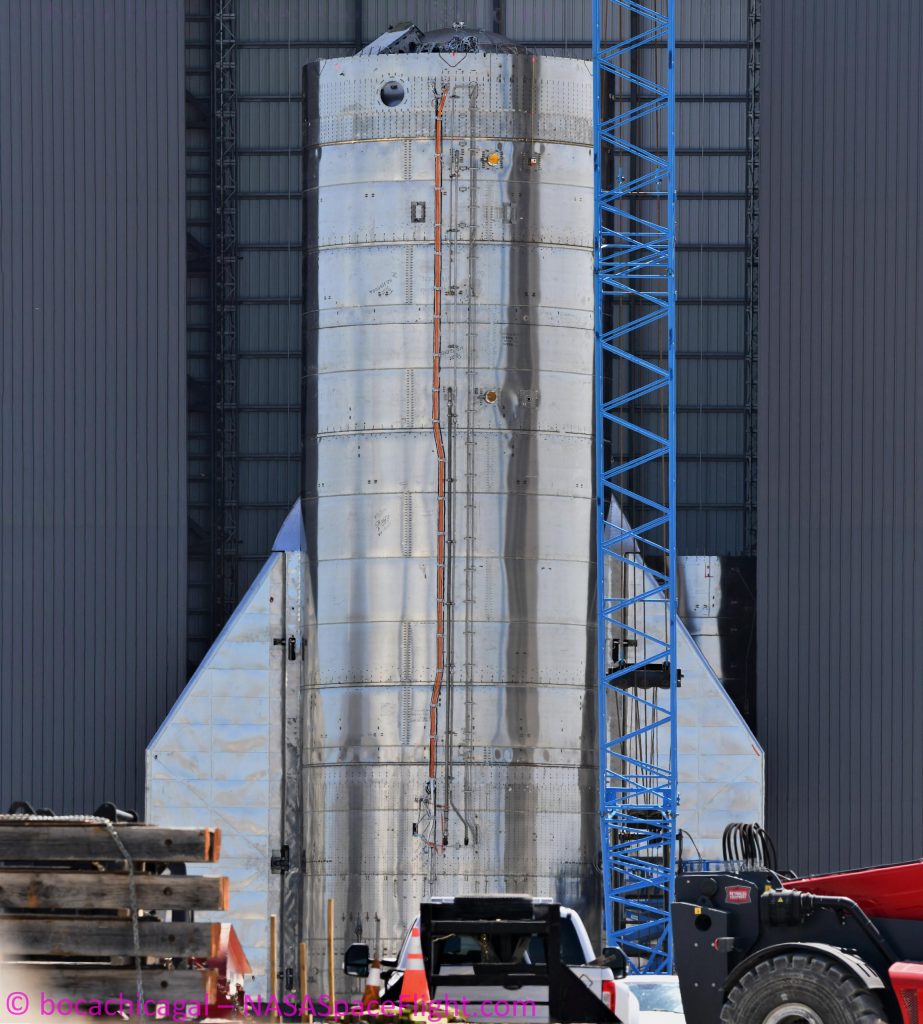
Doing so should reduce any inconvenience caused by vehicle failure in the event that Starship SN8’s acceptance test campaign doesn’t go as planned. In hindsight, the inclusion of Starship SN8’s aft flaps and aerocovers during the ship’s first major tests was likely a necessity, given that almost half of each flap and its support structure is installed directly to the skin of its liquid oxygen tank. Theoretically, when chilled to the temperature of liquid nitrogen or oxygen, the diameter of the stainless steel rings Starship SN8 is built out of could shrink by as much as 0.3% (~20 mm or ~0.8 in).
Only half of Starship SN8’s aft flaps will be directly subject to that tank contraction, resulting in a relatively complex environment for such a large, high-stress mechanical system. As such, testing flap actuation under cryogenic loads is likely a critical part of SN8’s cryogenic proof test, otherwise meant to demonstrate the structural integrity and functionality of Starship’s propellant tanks. If SN8 rolls to SpaceX’s launch facilities on schedule, the Starship’s first cryogenic proof test could begin as early as 9pm CDT (UTC-5) on Sunday, September 27th.
Check out Teslarati’s Marketplace! We offer Tesla accessories, including for the Tesla Cybertruck and Tesla Model 3.

Elon Musk
Elon Musk just said some crazy stuff about the Tesla Roadster

Elon Musk appeared on the Moonshots podcast with Peter Diamandis today to discuss AGI, U.S. vs. China, Tesla, and some other interesting topics, but there was some discussion about the upcoming unveiling of the Roadster, the company’s electric supercar that will arrive several years after it was initially slated for release.
Musk made some pretty amazing claims about the Roadster; we already know it is supposed to be lightning-fast and could even hover, if Tesla gets everything to happen the way it wants to. However, the car has some pretty crazy capabilities, some of which have not even been revealed.
On the podcast, Musk said:
“This is not a…safety is not the main goal. If you buy a Ferrari, safety is not the number one goal. I say, if safety is your number one goal, do not buy the Roadster…We’ll aspire not to kill anyone in this car. It’ll be the best of the last of the human-driven cars. The best of the last.”
🚨 Elon on the Roadster unveiling, scheduled for April 1:
— TESLARATI (@Teslarati) January 6, 2026
Musk makes a good point: people who buy expensive sports cars with ridiculous top speeds and acceleration rates do not buy them to be safe. They hope they are safe in case of an emergency or crash, but safety is not at the forefront of their thoughts, because nobody buys a car thinking they’ll crash it.
The Roadster is truly going to push the limits and capabilities of passenger vehicles; there’s no doubt about that. Tesla plans to show off the new version car for the first time on April 1, and Musk has only hinted at what is possible with it.
Musk said back in November:
“Whether it’s good or bad, it will be unforgettable. My friend Peter Thiel once reflected that the future was supposed to have flying cars, but we don’t have flying cars. I think if Peter wants a flying car, he should be able to buy one…I think it has a shot at being the most memorable product unveiling ever. [It will be unveiled] hopefully before the end of the year. You know, we need to make sure that it works. This is some crazy technology in this car. Let’s just put it this way: if you took all the James Bond cars and combined them, it’s crazier than that.”
Production is set to begin between 12 and 18 months after the unveiling, which would put the car out sometime in 2027. Hopefully, Tesla is able to stay on track with the scheduling of the Roadster; many people have been waiting a long time for it.
News
Tesla launches hiring for Robotaxi program in its twentieth country
Overall, the hiring signals Tesla’s aggressive timeline for global dominance in autonomous mobility.

Tesla has launched a hiring initiative for its Robotaxi program in its twentieth country, as the company posted two new jobs in Thailand this week.
Tesla is hiring in Bangkok and Kowloon for the Vehicle Operator position, which is related to data collection, and is the first in Thailand, but the twentieth country overall, as the company tries to expand into other markets.
🚨 BREAKING: Tesla is hiring additional full-time Vehicle Operators in Bangkok, Thailand.
Previous openings were 6-month, part-time roles. These are equivalent to AI Safety Operator roles in the U.S. pic.twitter.com/R6LzoU1bos— Tesla Yoda (@teslayoda) January 5, 2026
Tesla has had active job postings for Vehicle Operator positions in the United States, India, Israel, Taiwan, Germany, the Czech Republic, Hungary, the UK, Finland, Switzerland, Sweden, the Netherlands, Austria, Spain, Norway, Italy, and Turkey in past listings.
These postings are not all currently available, likely because the roles have been filled.
Thailand is the most recent, and broadens the company’s potential path to expanding its ride-hailing program, which is only active in the United States in Austin, Texas, and the California Bay Area, so far.
These roles typically involve data collection, which assists in improving Autopilot and Full Self-Driving operation. Tesla’s self-driving programs utilize real-world data that is accumulated and stored, observing vehicle and traffic behavior, as well as tendencies that are performed by human drivers to help increase safety and overall performance.
Overall, the hiring signals Tesla’s aggressive timeline for global dominance in autonomous mobility. Although the company has several high-profile rivals and competitors in the field, it has established itself as a main player and a leader in the development of autonomous technology, especially in the U.S., as its FSD suite is refined on almost a weekly basis.
The Full Self-Driving suite is available in seven countries and territories currently, including the U.S., Canada, China, Mexico, Puerto Rico, Australia, and New Zealand. Its biggest goal for expansion is currently the European market, where regulatory hurdles have been the main bottleneck prolonging its launch on the continent.
Tesla has performed months of testing in various European countries, including France and Spain, and does have support in some areas from various regulatory agencies. However, the company is hoping to get through this red tape and offer its suite in Europe for the first time, hopefully this year.
News
Tesla China rolls out Model Y upgrades, launches low-interest financing
These strategies are aimed at improving the ownership experience and keeping vehicle pricing competitive in the world’s largest electric vehicle market.

Tesla has rolled out minor updates to the five-seat Model Y in China, upgrading the vehicle’s center display to a higher-resolution 16-inch 2K screen. The electric vehicle maker also introduced attractive financing options, including 7-year low-interest rates, to offset the new purchase tax on EVs.
These strategies are aimed at improving the ownership experience and keeping vehicle pricing competitive in the world’s largest electric vehicle market.
Five-seat Model Y gets larger, better display
With its recent update, all three variants of the five-seat Model Y now feature an upgraded 16-inch 2K resolution center display, which replaces the vehicle’s previous 15.4-inch 1080p panel. This screen was already used in the six-seat Model Y L, and it offered improved visual clarity. Tesla China has also updated the Model Y’s headliner to black, giving the vehicle a sleeker appearance.
Prices of the five-seat Model Y remain unchanged at RMB 263,500, RMB 288,500, and RMB 313,500 for the respective trims. This update enhances the cabin experience as domestic rivals are already adopting high-resolution screens. As noted in a CNEV Post report, some domestic automakers have begun rolling out vehicles equipped with 3K-resolution displays.
New financing offers
Tesla also launched ultra-long-term financing offers for its locally produced models in China, which include the Model 3 sedan, the five-seat Model Y, and the six-seat Model Y L, through January 31, 2026. The 7-year option features an annualized fee rate as low as 0.5%, which is equivalent to 0.98% interest. This is expected to save customers up to RMB 33,479 ($4,790) compared to standard rates.
A 5-year zero-interest plan is also available, and it has been extended to the Tesla Model Y L for the first time. These incentives help offset China’s new 5% purchase tax on New Energy Vehicles (NEVs) in 2026-2027. Some of Tesla’s rivals in China have announced in recent months that they would be covering the purchase tax owed by buyers early this year.








